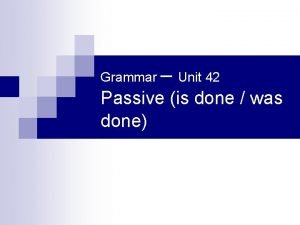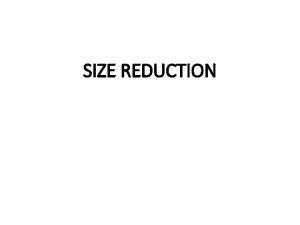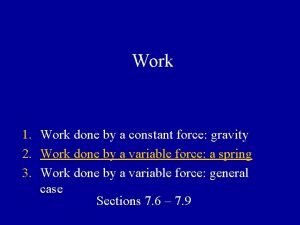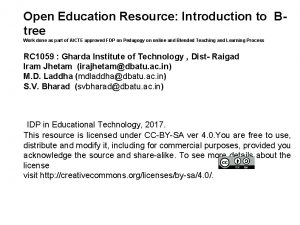Open Education Resource Power Point Slides Work done












- Slides: 12

Open Education Resource: Power Point Slides Work done as part of AICTE approved FDP on Pedagogy for Online and Blended Teaching-Learning Process RC-1278 - Group ID 1050 OER_201 x by Girish L V is licensed under a Creative Commons Attribution. Non. Commercial 4. 0 International License. Team Leader- Girish L. V. Team Members- Aveen K. P. , Rueben Obed Dsouza

Thermodynamic state of a system/substance: Exact condition of a system/substance is called state.

Thermodynamic process: When one or more of thermodynamic properties of a system change, we say that there is a change of state of the system. This change of state of a system is referred to as thermodynamic process. Fig. A Process between state 1 and state 2 and process path

Quasi-static process: A quasi-static process is one in which the deviation from equilibrium is infinitesimally small. All the states through which a system passes during a process can be considered as a succession of equilibrium states.

Thus quasi-equilibrium process takes place very slowly. If one property remains constant during a process, the prefix “iso” is used to describe such a process. E. g. Isothermal process – Constant temperature process Isobaric process – Constant pressure process Isochoric process – Constant volume process. Reversible and irreversible process: A process is called a reversible process if it can be completely reversed and the system and the surroundings come back to its original states. A process which cannot be exactly reversed and the system cannot be brought back to the initial state without leaving a net change in the surroundings is called irreversible process.

Thermodynamic cycle: When a number of processes in sequence bring the system back to its initial state, then the system is said to have undergone a thermodynamic cycle. In Fig 1 -2 -3 -4 -1 is cycle consisting of four processes. The change in value of any property is zero for a cyclic process.

Thermodynamic equilibrium: A system is in thermodynamic equilibrium if it is not capable of a finite spontaneous change to another state. i) Thermal equilibrium: When a system is in contact with its surroundings across a diathermal wall and if there is no spontaneous change in any of the properties of the system, the system is said to exist in thermal equilibrium with its surroundings. ii) Mechanical equilibrium: A system is said to be in mechanical equilibrium, when there is no unbalanced force acting on any part of the system or the system as a whole. iii) Chemical equilibrium: A system is said to be in chemical equilibrium, when there is no chemical reaction within the system and also there is no movement of any chemical constituent from one part of the system to the other.

Diathermal wall and Adiabatic wall: The envelope or boundary or surface enclosing a system may be a conductor or insulator. If this contacting wall or surface is a conductor which allows heat energy to pass through it, then it is called diathermal wall. If the conducting wall is an insulator which does not allow the heat to flow across the boundary, then it is called adiabatic wall. Fig. Diathermal wall Fig. Adiabatic wall

Zeroth law of thermodynamics: Statement: When two systems have thermal equilibrium with a third system, they in turn have thermal equilibrium with each other.

Thermometer and thermometric property: The Zeroth law provides the basis for the measurement of temperature. The third body 3 in Zeroth law is called thermometer. THERMOMETER THERMOMETRIC PROPERTY 1. Alcohol or mercury in glass Length 2. Electrical resistance Resistance 3. Thermocouple Electromotive force 4. Constant volume gas Pressure 5. Constant pressure gas Volume 6. Radiation (Pyrometer) Intensity of radiation

Temperature scales: We know that temperature is a function of resistance R, emf E, pressure P, volume V and radiation intensity I in case of electric resistance thermometer, thermocouple, constant volume thermometer, constant pressure thermometer and radiation thermometer respectively. In establishing a temperature scale we need a relationship between the temperature and thermometric property. Direct proportionality : t = Ax Linear relation : t = ax + b Quadratic relation : t = αx 2 + βx + ϒ Polynomial : A’ + B’x + C’x 2 + D’x 3 + ……. .

The temperature of -2730 C in Celsius scale and -4600 F in case of Fahrenheit scale is called absolute zero temperature. The temperature measured from this zero is called absolute temperature. The absolute temperature in Celsius scale is called degree Kelvin (K), Similarly the absolute temperature in Fahrenheit scale is called degree Rankine (R),
 Unit 42 passive 1
Unit 42 passive 1 Cutter mill principle
Cutter mill principle Aldanma cahilin kuru lafına
Aldanma cahilin kuru lafına 영국 beis
영국 beis A small child slides down the four frictionless slides
A small child slides down the four frictionless slides Energy release quick check
Energy release quick check Power triangle diagram
Power triangle diagram Power bi power point
Power bi power point Point point power
Point point power Resource loading vs resource leveling
Resource loading vs resource leveling Perbedaan resource loading dan resource levelling
Perbedaan resource loading dan resource levelling What is intelligent sharing of power
What is intelligent sharing of power The work done by gravity during the descent of a projectile
The work done by gravity during the descent of a projectile























